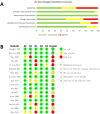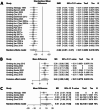Superior efficacy of 100-Hz transcutaneous electrical nerve stimulation in reducing post-stroke spasticity: a systematic review and meta-analysis
- PMID: 41068908
- PMCID: PMC12512259
- DOI: 10.1186/s12984-025-01744-3
Superior efficacy of 100-Hz transcutaneous electrical nerve stimulation in reducing post-stroke spasticity: a systematic review and meta-analysis
Abstract
Background: Post-stroke spasticity is a prevalent complication of upper motor neuron injury, hindering motor recovery, independence, and quality of life. Transcutaneous electrical nerve stimulation (TENS) has been proposed as a non-invasive strategy to modulate neural excitability and reduce spasticity. However, its clinical efficacy remains uncertain due to heterogeneity in stimulation protocols and patient characteristics. This systematic review and meta-analysis aimed to assess the overall effectiveness of TENS in managing post-stroke spasticity and to examine potential differences in outcomes across stimulation frequencies and stroke phases.
Methods: Databases searched included PubMed, Embase, Web of Science, Scopus, PEDro, and the Cochrane Library up to March 2025. The primary outcome was spasticity severity, assessed using the Modified Ashworth Scale (MAS) or Composite Spasticity Score (CSS). Subgroup analyses were conducted by stimulation frequency and stroke stage. Standardized mean differences (SMDs) were calculated using a random-effects model. Risk of bias was assessed using the Cochrane RoB 2.0 tool.
Results: Seventeen randomized controlled trials (RCTs) involving 913 participants were included. TENS significantly reduced post-stroke spasticity compared to controls (SMD = - 0.64; 95% CI: - 0.91 to - 0.37; P < 0.001; I² = 69%). Subgroup analysis revealed the greatest effect in the acute phase (SMD = - 1.77), followed by subacute (SMD = - 0.61) and chronic phases (SMD = - 0.44) (p for subgroup difference < 0.001). TENS at 100 Hz yielded significant improvement (SMD = - 0.69), whereas lower frequencies (< 100 Hz) did not reach statistical significance. However, between-frequency group differences were not statistically significant (P = 0.67). Sensitivity analyses confirmed the robustness of the findings. Egger's test suggested potential publication bias (P = 0.008).
Conclusions: TENS is a safe and effective intervention for reducing post-stroke spasticity, especially when applied during the acute phase. High-frequency stimulation at 100 Hz may confer greater benefits, though further standardized studies are needed to validate optimal parameters and timing. These results support the early incorporation of 100 Hz TENS into comprehensive stroke rehabilitation protocols. PROSPERO registration number: CRD 420251029133.
Keywords: High-frequency stimulation; Meta-analysis; Neurorehabilitation; Spasticity; Stroke; TENS; Transcutaneous electrical nerve stimulation.
© 2025. The Author(s).
Conflict of interest statement
Declarations. Ethics approval and consent to participate: Not applicable. Consent for publication: All authors have approved this manuscript for publication. This manuscript has not previously been published and is not pending publication elsewhere Competing interests: The authors declare no competing interests.
Figures









References
-
- Urban PP, Wolf T, Uebele M, Marx JJ, Vogt T, Stoeter P, et al. Occurence and clinical predictors of spasticity after ischemic stroke. Stroke. 2010;41(9):2016–20. 10.1161/strokeaha.110.581991. Epub 20100812. - PubMed
-
- Mills PB, Dossa F. Transcutaneous electrical nerve stimulation for management of limb spasticity: A systematic review. Am J Phys Med Rehabil. 2016;95(4):309–18. 0000000000000437. PubMed PMID: 26829077. - PubMed
-
- Mahmood A, Veluswamy SK, Hombali A, Mullick A, Solomon NM. Effect of transcutaneous electrical nerve stimulation on spasticity in adults with stroke: A systematic review and Meta-analysis. Arch Phys Med Rehabil. 2019;100(4):751–68. 10.1016/j.apmr.2018.10.016. Epub 20181116. - PubMed
Publication types
MeSH terms
LinkOut - more resources
Full Text Sources
Medical

